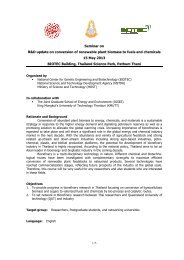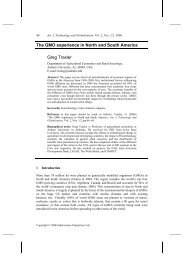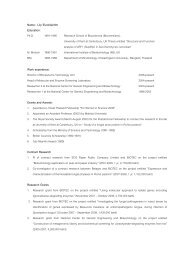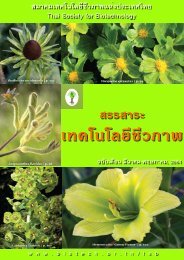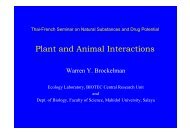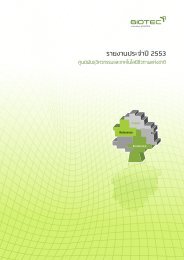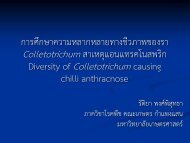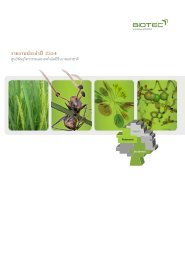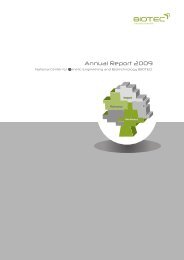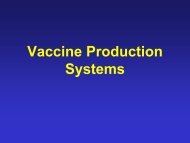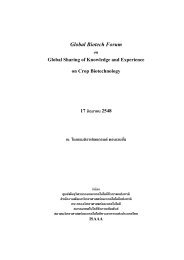Boonyapiwat, S. 1989. Species of phytoplankton <strong>in</strong> the occurrence of red tides <strong>in</strong> the Gulf of<strong>Thailand</strong>. The Proceed<strong>in</strong>gs of the Fourth National Conference of Mar<strong>in</strong>e Science, <strong>Coastal</strong>Resource Section, 9p.Boromthanarat, S. 1994. <strong>Coastal</strong> zone management. In: Workshop on environmental assessmentand management of aquaculture (draft report). Third Meet<strong>in</strong>g of the Technical AdvisoryCommittee (TAC-3) of the Network of <strong>Aquaculture</strong> Centres of Asia–Pacific, Hanoi,S.R. Vietnam, 27–30 September 1994, III, 10–14.Boyd, C.E. 1989. Water quality management and aeration <strong>in</strong> shrimp farm<strong>in</strong>g. Fisheries andAllied <strong>Aquaculture</strong>s Departmental Series No. 2. Alabama, USA, Auburn University, 183p.Briggs, M.R.P. 1992. A stress test <strong>for</strong> determ<strong>in</strong><strong>in</strong>g vigour of post-larval Penaeus monodonFabricius. <strong>Aquaculture</strong> and Fisheries Management, 23, 633–637.Briggs, M.R.P. 1993a. Water quality and treatment <strong>in</strong> susta<strong>in</strong>able shrimp farm<strong>in</strong>g. Paper presentedat the Tenth Year Anniversary Conference of the T<strong>in</strong>sulanonda Songkhla FisheriesCollege, Songkhla, <strong>Thailand</strong>, 2–4 June 1993, 35p.Briggs, M.R.P. 1993b. Water quality <strong>in</strong> susta<strong>in</strong>able shrimp farm<strong>in</strong>g. Paper presented at theThird Academic and <strong>Research</strong> Conference <strong>for</strong> Southern <strong>Thailand</strong> Technical Colleges,Krabi, <strong>Thailand</strong>, 23–25 July 1993, 20p.Briggs, M.R.P. and Funge-Smith, S.J. 1993. A nutrient budget of some <strong>in</strong>tensive mar<strong>in</strong>eshrimp ponds <strong>in</strong> <strong>Thailand</strong>. <strong>Aquaculture</strong> and Fisheries Management (<strong>in</strong> press).Briggs, M.R.P. and Funge-Smith, S.J. 1994. Unsusta<strong>in</strong>able shrimp culture—causes and potentialsolutions from experience <strong>in</strong> <strong>Thailand</strong>. Appendix 2. In: Development of strategies <strong>for</strong>susta<strong>in</strong>able shrimp farm<strong>in</strong>g. F<strong>in</strong>al report to the Overseas Development Adm<strong>in</strong>istration.Stirl<strong>in</strong>g, Scotland, Institute of <strong>Aquaculture</strong>, University of Stirl<strong>in</strong>g, 31p.Brooks, D. 1990. Beyond the catch phrases: what does susta<strong>in</strong>able development really mean?International Development <strong>Research</strong> Center (of Canada) Reports, 18, 24–25.Chaiyukum, K., Songsangj<strong>in</strong>da, P. and Tanvilai, D. 1992. Water quality and production of twomanagement systems <strong>in</strong> <strong>in</strong>tensive shrimp farms <strong>in</strong> the Songkla area. National Institute of<strong>Coastal</strong> <strong>Aquaculture</strong>, Songkhla, <strong>Thailand</strong>. Department of Fisheries Technical Paper, 11,14p.Chaiyakum, K. and Tanvilai, D. 1989. Use of mussel and Gracilaria to treat the effluent waterfrom <strong>in</strong>tensive shrimp ponds. National Institute <strong>for</strong> <strong>Coastal</strong> <strong>Aquaculture</strong>, Songkhla, <strong>Thailand</strong>.Department of Fisheries Technical Paper, 1, 26p.Chanratchakool, P., Turnbull, J.F., Funge-Smith, S.J., MacRae, I.H., Limsuwan and C. 1998.Health management <strong>in</strong> shrimp ponds. Bangkok, Aquatic Animal Health <strong>Research</strong> Institute,Kasetsart University, 152p.Chanratchakool, P., Turnbull, J. and Limsuwan, C. 1994. Health management <strong>in</strong> shrimp ponds.Bangkok, Aquatic Animal Health <strong>Research</strong> Institute, Department of Fisheries, KasetsartUniversity Campus, 89p.Chen, S.N. 1990. Collapse and remedy <strong>for</strong> the shrimp culture <strong>in</strong>dustry <strong>in</strong> Taiwan. Taiwan,Department of Zoology, National Taiwan University.Chiang, H.C. and Lee, J.C. 1986. Study of the treatment and re-use of aquacultural wastewater<strong>in</strong> Taiwan. Aquacultural Eng<strong>in</strong>eer<strong>in</strong>g, 5, 301–312.Chien, Y.H. 1992. <strong>Aquaculture</strong> <strong>in</strong> the Republic of Ch<strong>in</strong>a: a biosocioeconomic analysis of theaquaculture <strong>in</strong>dustry <strong>in</strong> Taiwan. In: <strong>Aquaculture</strong> <strong>in</strong> Asia. Proceed<strong>in</strong>gs of the 1990 AsianProductivity Organization (APO) Symposium on <strong>Aquaculture</strong>, Taiwan Fisheries <strong>Research</strong>Institute. Tokyo, APO, 31–50.Ch<strong>in</strong>danon, A. 1991. Report of the occurrence of red tides <strong>in</strong> the Gulf of <strong>Thailand</strong> and the surveillanceplan of the Department of Fisheries <strong>in</strong> the occurrence of red tides. Bangkok, TheDepartment of Fisheries, 8p.Ch<strong>in</strong>tatum, T. 1991. Today’s fisheries world. Aquatic Fauna, 2, 107–108.%#
Csavas, I. 1988. <strong>Shrimp</strong> farm<strong>in</strong>g development <strong>in</strong> Asia. In: <strong>Shrimp</strong> ’88, Bangkok, <strong>Thailand</strong>,26–28 January 1988. Kuala Lumpur, Malaysia, Infofish, 63–92.DOF (Department of Fisheries) 1992. Experiments on green mussel, Mytilus sp., and seaweed,Gracilaria sp. <strong>for</strong> biological wastewater discharge treatment from <strong>in</strong>tensive shrimp ponds.Bangkok, National Institute of <strong>Coastal</strong> <strong>Aquaculture</strong>, Department of Fisheries TechnicalPaper No. 5, 24p.DOF (Department of Fisheries) 1994. Country paper: <strong>Thailand</strong>. ASEAN (Association ofSouth-East Asian Nations) Conf/Policy/6. Conference on Fisheries Management andDevelopment Strategies <strong>for</strong> the ASEAN Region <strong>for</strong> the Year 2000, Bangkok, <strong>Thailand</strong>.Bangkok, DOF, M<strong>in</strong>istry of Cooperatives, 22p.Dixon, J.A., Carpenter, R.A., Fallon. L.A., Shermann, P.B. and Manopimoke, S. 1988. Economicanalysis of environmental analysis of development projects. London, EarthscanPublications, 125p.Dovers, S. and Handmer, J. 1994. Contradictions of susta<strong>in</strong>ability. The concept of susta<strong>in</strong>abilityis riddled with conflicts and paradoxes. Tropical Forest Update, 4(2), 4–5.FAO (Food and Agriculture Organization of the United Nations) 1991. Environment and susta<strong>in</strong>ability<strong>in</strong> fisheries. COFI/91/3. Document presented at the 19th Session of the Committeeon Fisheries, 8–12 April 1991, Rome, Italy, 23p.Fast, A.W., Carpenter, K.E., Estilo, V.J. and Gonzales, H.J. 1988. Effects of pond depth andartificial mix<strong>in</strong>g on dynamics of Philipp<strong>in</strong>es brackishwater shrimp ponds. AquaculturalEng<strong>in</strong>eer<strong>in</strong>g, 7, 349–361.Fegan, D.F. 1994. Environmental assessment and management of aquaculture development:an <strong>in</strong>dustry perspective. In: Workshop on environmental assessment and management ofaquaculture (draft report). Third Meet<strong>in</strong>g of the Technical Advisory Committee (TAC-3)of the Network of <strong>Aquaculture</strong> Centres of Asia–Pacific, Hanoi, S.R. Vietnam, 27–30 September1994, III, 18–29.Flegal, T. 1992. Insecticide danger to shrimp. Letter cited <strong>in</strong> <strong>Aquaculture</strong> News from Aroundthe World. Infofish, 6, 36.Flegel, T.W. 1996. A turn<strong>in</strong>g po<strong>in</strong>t <strong>for</strong> susta<strong>in</strong>able aquaculture: the white spot virus crisis <strong>in</strong>Asian shrimp culture. <strong>Aquaculture</strong> Asia, July–September, 29–34.Funge-Smith, S. 1997. <strong>Thailand</strong>. World shrimp farm<strong>in</strong>g 1997. In: Rosenberry, B., ed., <strong>Shrimp</strong>News International, 142–154.Hirasawa, Y. 1992. Economic analysis of prawn culture <strong>in</strong> Asia. In: <strong>Aquaculture</strong> <strong>in</strong> Asia. Proceed<strong>in</strong>gsof the 1990 Asian Productivity Organization (APO) Symposium on <strong>Aquaculture</strong>.Taiwan Fisheries <strong>Research</strong> Institute, 201–222.Hopk<strong>in</strong>s, J.S., Stokes, A.D., Browdy, C.L. and Sandifer, P.A. 1991. The relationship betweenfeed<strong>in</strong>g rate, paddlewheel aeration rate and expected dawn dissolved oxygen <strong>in</strong> <strong>in</strong>tensiveshrimp ponds. Aquacultural Eng<strong>in</strong>eer<strong>in</strong>g, 10, 281–290.Jacobs, M. 1991. The Green Economy. London, Pluto Press.Jitsanguan, T., Mungk<strong>in</strong>, N. and Claithong, W. 1993. Susta<strong>in</strong>able coastal resource management<strong>in</strong> <strong>Thailand</strong>: the case study of shrimp cultivation at Pak Panang Bay. <strong>Research</strong> papersubmitted to Asian Fisheries Social Science <strong>Research</strong> Network (AFSSRN), <strong>Thailand</strong>,106p.Kakork<strong>in</strong>, C. and Sunaryanto, A. 1994. Why do some shrimp farms fail? Eurasian <strong>Aquaculture</strong>,4, 7–8.Kapetsky, J.M. 1987. Conversion of mangroves <strong>for</strong> pond aquaculture: some short-term andlong-term remedies. In: Report of the workshop on the conversion of mangrove areas toaquaculture, Iloilo City, Visayas, Philipp<strong>in</strong>es, April 24–26 1986. UNDP/UNESCO (UnitedNations Development Programme/United Nations Educational Scientific and CulturalOrganization) Regional Project on <strong>Research</strong> and its Application to the Management of theMangroves of Asia and the Pacific, New Delhi, India, March 1987, 96–106.%$
- Page 8 and 9:
!The 1994 Workshop had a working hy
- Page 11 and 12:
!The Workshop at Hat Yai, SongkhlaA
- Page 13 and 14: !ReferenceSmith, P.T., ed.. 1999. T
- Page 15 and 16: !Shrimp Farming in ThailandOver the
- Page 18 and 19: ! !Table 1. World production (# 1,0
- Page 20 and 21: !Domestic and world demandJapan is
- Page 22 and 23: !Intensification of farms has been
- Page 24 and 25: !no significant difference between
- Page 26 and 27: !Production Practices and Technique
- Page 28 and 29: !use water which is almost fresh (F
- Page 30 and 31: !mended quantities for application
- Page 32 and 33: !the biological processes in sedime
- Page 34 and 35: !factors (Fegan 1994). Environmenta
- Page 36 and 37: !Acid sulphate soils occur in most
- Page 38 and 39: during the rainy season, some deter
- Page 40 and 41: Land subsidenceCoastal land subside
- Page 42 and 43: first when an area becomes environm
- Page 44 and 45: !Administration. Their work has inv
- Page 46 and 47: agriculture, selects coastal land p
- Page 48 and 49: Sustainability, Sustainable Develop
- Page 50 and 51: cultural and environmental asset va
- Page 52 and 53: $+Table 12. (cont’d) Impediments
- Page 54 and 55: $#Table 12. (cont’d) Impediments
- Page 56 and 57: $%Table 12. (cont’d) Impediments
- Page 58 and 59: capacities of alternative organisms
- Page 60 and 61: sources. This is one of the greates
- Page 62 and 63: Table 13. (cont’d) Summary of the
- Page 66 and 67: Katesombun, B. 1992. Aquaculture pr
- Page 68 and 69: Sirisup, S. 1988 Socio-economic cha
- Page 70 and 71: !In the preliminary analysis, the s
- Page 72 and 73: !until all variables had been teste
- Page 74 and 75: !quality problem over the past 3 ye
- Page 76 and 77: !Figure 1. Characterisation of prov
- Page 78 and 79: !Variables Contributing to Shrimp P
- Page 80 and 81: !Figure 5. Relationship between ave
- Page 82 and 83: !southern). The linear regression m
- Page 84 and 85: !Appendix. Results of logistic regr
- Page 86 and 87: !2) Trat ProvinceClassification tab
- Page 88 and 89: !Chi-square df significanceModel Ch
- Page 90 and 91: !8) Satun ProvinceClassification ta
- Page 92 and 93: !Variables in the equationConstant
- Page 94 and 95: !A total of 49 participants were in
- Page 96 and 97: ! ! ! ! ! ! ! ! ! ! ! ! ! ! ! ! !Fi
- Page 98 and 99: !All issues are listed in Appendice
- Page 100 and 101: !!were short term and one issue was
- Page 102 and 103: !reared broodstock (issue 71). They
- Page 104 and 105: !!Two participants commented that i
- Page 106 and 107: mation transfer and training. This
- Page 108 and 109: 108Appendix 1. (cont’d) Descripti
- Page 110 and 111: 110Appendix 1. (cont’d) Descripti
- Page 112 and 113: 112Appendix 2. Descriptive statisti
- Page 114 and 115:
114Appendix 2. (cont’d) Descripti
- Page 116 and 117:
116Appendix 3. Descriptive statisti
- Page 118 and 119:
118Appendix 4. Descriptive statisti
- Page 120 and 121:
120Appendix 5. Descriptive statisti
- Page 122 and 123:
Appendix 5. (cont’d) Descriptive
- Page 124 and 125:
Appendix 7. Descriptive statistics
- Page 126 and 127:
Appendix 7. (cont’d) Descriptive
- Page 128 and 129:
128Appendix 8. (cont’d) Descripti
- Page 130 and 131:
!ParticipantsAustraliaDr Paul T. Sm



